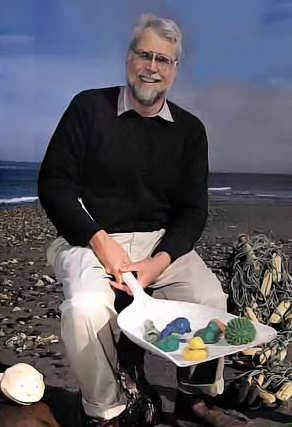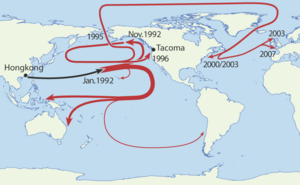Friendly Floatees facts for kids

Friendly Floatees are plastic bath toys. They became famous because of a special event in 1992. About 29,000 of these toys were lost at sea. They included yellow ducks, red beavers, blue turtles, and green frogs.
An oceanographer named Curtis Ebbesmeyer used these toys to study ocean currents. Ocean currents are like giant rivers in the ocean. Some toys landed on shores like Hawaii. Others traveled over 17,000 miles. They even floated near where the Titanic sank. Some were frozen in Arctic ice for years. They reached the Eastern Seaboard, British, and Irish shores 15 years later in 2007.
Contents
How the Toys Helped Science
The Friendly Floatee toys were made in China. They were being shipped from Hong Kong to Tacoma, Washington, in the U.S. This happened on a ship called the Ever Laurel.
On January 10, 1992, a big storm hit the North Pacific Ocean. Twelve large shipping containers fell overboard. One container held 28,800 Floatees. These were bath toys shaped like red beavers, green frogs, blue turtles, and yellow ducks. The container opened, and the toys floated free. Unlike many bath toys, these Floatees had no holes. This meant they did not fill with water and sink.
Tracking the Toys
Two scientists from Seattle, Curtis Ebbesmeyer and James Ingraham, started tracking the toys. They were already studying ocean currents. Losing so many toys at once was a great chance for them. Usually, scientists release only 500 to 1,000 special bottles to track currents. With 28,800 toys, they hoped to get much more information. They had also tracked 61,000 Nike running shoes lost in 1990.
Ten months later, the first Floatees began to appear. They washed up along the coast of Alaska. On November 16, 1992, a beachcomber found ten toys near Sitka, Alaska. This was about 2,000 miles (3,200 km) from where they started. Ebbesmeyer and Ingraham asked people living near the coast to help. They found hundreds of toys along 530 miles (850 km) of shoreline.
Predicting Ocean Paths
The scientists used a computer model called OSCUR. This model uses air pressure data to figure out wind speed and direction. It then calculates how ocean surface currents move. OSCUR helps predict where things floating in the ocean might go. It is also used to find people lost at sea.
Using their models, the scientists correctly guessed that more toys would reach Washington state in 1996. They also thought many toys would travel to Alaska, then to Japan, and back to Alaska. After that, they predicted the toys would drift north. They would go through the Bering Strait and get stuck in the Arctic ice.
The scientists believed it would take five or six years for the toys to cross the North Pole with the ice. Then, the ice would melt in the North Atlantic, releasing the toys. From July to December 2003, the toy company offered a $100 reward. This was for anyone who found a Floatee in New England, Canada, or Iceland. More toys were found in 2004 than in the previous three years.
Scientists predicted even more toys would head east past Greenland. They thought these toys would land on the southwestern shores of the United Kingdom in 2007. In July 2007, a retired teacher found a plastic duck in England. Newspapers excitedly reported that the Floatees had arrived. However, a scientist later checked the duck. He found it was not one of the original Friendly Floatees.
The ducks and beavers had turned white from the sun and seawater. But the turtles and frogs kept their original colors.
The Toys' Lasting Impact
The story of the Friendly Floatees inspired several books.
- Eric Carle wrote a children's book called 10 Little Rubber Ducks in 2005.
- Another children's book, Ducky, was published in 2004. It was written by Eve Bunting and illustrated by David Wisniewski.
- In 2011, Donovan Hohn published Moby-Duck: The True Story of 28,800 Bath Toys Lost at Sea and of the Beachcombers, Oceanographers, Environmentalists, and Fools, Including the Author, Who Went in Search of Them.
The toys themselves have become collector's items. Some have sold for as much as $1,000.
In 2014, The Disney Channel and Disney Junior aired an animated movie called Lucky Duck. This movie was loosely based on the story of the Friendly Floatees.
See also
 In Spanish: Friendly Floatees para niños
In Spanish: Friendly Floatees para niños


